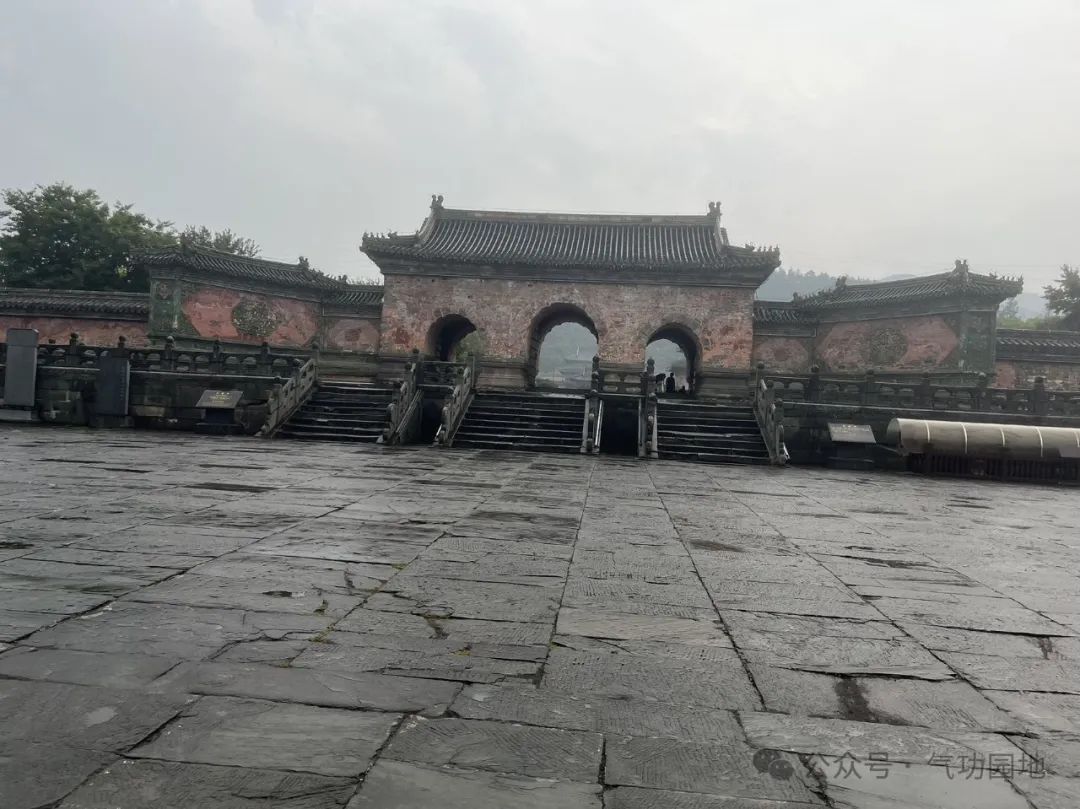
In the past, I was physically weak, particularly sensitive to cold, and often caught colds. Later, I learned Kunlun Qigong from a folk master, and my health improved significantly, and I felt more energetic.
Even in the cold winter, I only need to wear a single layer of clothing. Through years of practice, I have summarized some insights and combined them with the Kunlun Qigong taught by my master to create the following cold-resistance health exercises.
This method is primarily based on the principle of “full essence is not afraid of cold” from Qigong theory, combined with breathing techniques, which not only helps resist the cold but also strengthens the muscles and bones. This practice is particularly suitable for middle-aged and elderly individuals, as well as for younger friends who are often ill and have weak constitutions.
1. Morning Practice
Stand with your feet slightly wider than shoulder-width apart, knees slightly bent, standing naturally, and breathing naturally. Close your eyes lightly.
1. Expel the Old and Inhale the New
Inhale slowly through the nose, imagining the pure essence of nature entering your body through your nostrils, cleansing your entire body inside and out. When exhaling, gently contract your abdomen and exhale through your mouth, imagining the turbid air being expelled. Repeat this nine times.
It is best to practice this in the morning after waking up, as it can thoroughly cleanse the turbid air from your body. Once this habit is formed, practicing for ten minutes in the morning can help maintain good energy throughout the day. It serves to expel the old and inhale the new, refreshing the mind.
Initially, during practice, limit your breathing to nine cycles; if you do more, those with weak constitutions may feel cold. Generally, aim for a refreshing sensation.
During breathing, try to take deeper breaths, but do not tense up; the focus should be on relaxed breathing. I believe that within a week of practice, most practitioners will master this balance of breathing and relaxation.
2. Cold-Resistance Breathing Technique.
To resist the cold, holding your breath is the quickest method; here, we add breathing techniques to help everyone warm up faster during winter practice.
The posture is the same; when inhaling, concentrate on gathering energy in the Dantian (丹田), then hold your breath. Do not force it; just hold it naturally for a while.
While holding your breath, let the energy gathered in the Dantian circulate along the Da Zhou Tian (大周天) route, which is from the Dantian to Yongquan (涌泉) to Huiyin (会阴) to Baihui (百会) to Laogong (劳宫) to Shanzhong (膻中) and back to the Dantian. When circulating the energy, there is no need to visualize it too precisely; a natural, light awareness is better, and the speed of energy circulation should be moderate to fast.
Simply think of the route, and once the energy returns to the Dantian, exhale naturally, imagining the energy permeating your entire body. After a few natural breaths, repeat the breath-holding and energy circulation technique. Practice this nine times.
Generally, after a few rounds of breath-holding practice, weak individuals will generate internal heat, and consistent practice will help form an energy mass in the Dantian. It is important to remind everyone that the focus of this cold-resistance practice should be on the energy, not on the intention. Additionally, after each cycle of inhalation and breath-holding, you should take a few natural breaths to prevent energy stagnation. When visualizing the energy circulating along the Da Zhou Tian, just think of it lightly; if you focus too much, the breath-holding will not last long.
If you feel the urge to exhale before completing a full cycle of the Da Zhou Tian, then exhale naturally without tension; it will not cause any adverse effects.
For those who are weak and sensitive to cold, be cautious with inhalation; do not forcefully gather the energy from nature into the Dantian, as this may cause you to feel cold, especially with the winter approaching. If you cannot control the pure energy entering your body, it may lead to a sensation of cold.
This is something to be mindful of. Once your constitution improves and you no longer fear the cold, you can add the intention of inhaling energy into the Dantian.
Through this practice method, generally, within about a month, an energy mass will form in the Dantian, and during the initial learning process, practitioners may experience the “eight touches” phenomenon of Qigong, mostly feeling warmth. This is a normal occurrence.

3. Sunlight Health Posture
Place your palms about thirty centimeters away from your abdomen in a hugging position, gently envisioning a sun in your Dantian, radiating bright golden light that warms your entire body, making it feel warm and clear.
After standing for ten minutes, you can conclude the practice. To conclude: rub your palms together to warm them, massage your head, face, and eyes, pat your Mingmen (命门), and move all your joints, taking three deep breaths. Practice this every morning for about thirty minutes.
Editor’s Note: The most challenging aspect of winter health is dealing with cold resistance and warming the body. Practicing Qigong and soaking your feet are undoubtedly effective methods. Here, we recommend two cold-resistance warming methods: the supine position and the horse-riding squat position for Qigong enthusiasts to choose from.
Two Techniques for Cold-Resistance Qigong to Combat Winter Cold
1. Supine Position
Lie on your back on the bed, covered with a cotton quilt. The quilt should ideally be soft, lightweight, and warm, such as silk or duck down.
Lie flat with your feet shoulder-width apart, arms at your sides, one fist away from your body, fingers naturally extended, palms facing down. The pillow should be about ten centimeters high, eyes lightly closed, lips gently touching, and the tongue lightly touching the upper palate.Content from the Martial Arts Dan Dao Qigong public account.Eliminate distractions,focus on the Dantian,and visualize a bright red sun in the Dantian radiating warmth throughout the body.
Use abdominal breathing, inhaling through the nose and exhaling through the mouth, ensuring the breath is smooth, deep, and long while calming the mind. At the same time, relax from head to toe, repeating the relaxation process 3-5 times. After relaxing, focus on the Dantian for 30 minutes, then slowly conclude the practice, getting up to move around or peacefully falling asleep.

Practicing this method focuses on relaxation and stillness, concentrating on the Dantian, and visualizing warm energy radiating throughout the body. During practice, saliva may accumulate; when you swallow it, imagine it reaching the Dantian, harmonizing water and fire, generating endless vitality.
According to relevant Qigong literature and clinical reports, those who achieve significant results in practice often feel a noticeable warmth in their hands, feet, and abdomen within three to five minutes. Content from the Martial Arts Dan Dao Qigong public account. Experimental reports indicate that among 15 practitioners, 14 experienced an increase in skin temperature of nearly 2°C in their palms after practice, demonstrating that Qigong training is an effective way to resist cold and warm the body.
For those practicing this method, if there are no issues with high blood pressure or cardiovascular diseases, it can be combined with breath-holding techniques for even better cold-resistance and warming effects. The specific method is: after fully relaxing, take a few deep breaths.
When inhaling, try to expand your abdomen as much as possible; when you can no longer inhale, hold your breath, counting silently until you can no longer hold it, then pause for a few seconds and slowly exhale while relaxing your entire body.
Then, pause for a few seconds, inhale slowly while expanding your abdomen and holding your breath, counting until you can no longer hold it, pause for a few seconds, then exhale and relax. Repeat this process 3-5 times.
It should be noted that the breath-holding technique has a significant impact on the circulatory system and is effective for cold resistance and warming, but it is not suitable for individuals with high blood pressure or cardiovascular diseases.

2. Horse-Riding Squat Position
Assume a standing position with your feet naturally apart, shoulder-width apart, keeping your upper body straight, head upright, chest in, abdomen in, and back straight.
Breath naturally, ensuring it is smooth, deep, and long, without gasping. Close your eyes lightly, lips slightly together, tongue touching the upper palate. Eliminate distractions, calm your mind, and relax your entire body while focusing on the Dantian.
After relaxing, lower your center of gravity, engaging your legs, and slowly raise your arms from your sides while slightly bending your knees and lowering your upper body. When your arms reach shoulder level, squat down into a horse-riding position, allowing your elbows to drop and your palms to move in a circular motion towards your chest, repeating this 36 times.
Then, slowly return to a standing position, clench your teeth 100 times, and swallow the saliva, sending it to the Dantian.
It is important to emphasize that during this practice, the movements of the arms and teeth clenching should be gentle and slow; avoid impatience and rigidity. This practice, using the horse-riding squat position combined with arm movements, can help clear the meridians throughout the body, and clenching the teeth and swallowing saliva can strengthen the body. As long as you adhere to the practice, you can expect to wear only a shirt and sweater in the harsh winter without feeling cold, feeling energetic and light on your feet.

1. Patients should adopt a sitting or leaning position for optimal practice.
2. In the initial stages of practice, patients should not overly focus on breathing to quickly achieve relaxation and self-regulation. If they rush to achieve results, or focus too much on posture or frequency, or suddenly increase the amplitude of abdominal breathing, it will inevitably lead to discomfort such as breathlessness, chest tightness, or suffocation. The concept of “natural” is particularly important for asthma patients; often, forcing the breath will not only fail to alleviate asthma but may also worsen the situation due to increased tension and disrupted breathing.
3. Once patients learn to relax their entire body, they can then learn to relax the chest, combining local relaxation with overall relaxation, which will be more beneficial for alleviating asthma. During an asthma attack, they should first relax the local area, then relax the entire body, or relax the local area while maintaining overall relaxation. If there is tension in a specific area, they can gradually relax it from the main bronchus to the large bronchus, from top to bottom, and from left to right. Alternatively, they can focus on the concept of relaxation rather than on the specific area, and combine it with chest massage. Initially, there may be slight tension in the bronchial area, but this will naturally disappear after 3-4 days of practice. When asthma symptoms improve, local relaxation may not be necessary, and experienced practitioners can achieve relaxation naturally with their breath.
4. During an asthma attack, caregivers must immediately guide the patient to perform relaxation exercises. Gently press on the three lines of the body, adjusting according to the patient’s breathing speed, pressing during inhalation and saying “relax” during exhalation (but without making the patient aware, to avoid focusing their attention on breathing), and gradually guiding the patient to slow their breathing rate. The practice should be as natural as possible, neither too fast nor too slow, patiently leading the patient to relax until the asthma attack subsides, usually within 2-3 cycles or slightly longer.
Precautions
1. Prepare for practice according to the different conditions of patients; for those with coughs, drink some warm water beforehand or suck on licorice lozenges to soothe the throat; for those with nasal congestion, use ephedrine nasal drops beforehand.
2. After achieving certain results in practice, it is essential to continue to maintain the practice to consolidate the effects.
3. Pay attention to sudden changes in weather and ensure timely warmth and wind protection to avoid triggering factors.Taishang Neiguan Method (Dan Dao Foundation Class)

